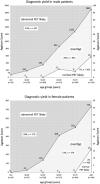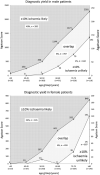The power of zero calcium in 82-Rubidium PET irrespective of sex and age
- PMID: 36624363
- PMCID: PMC10371904
- DOI: 10.1007/s12350-022-03174-3
The power of zero calcium in 82-Rubidium PET irrespective of sex and age
Abstract
Background: Despite clinical suspicion, many non-invasive tests for coronary artery disease (CAD) are normal. Coronary artery calcification score (CACS) is a well-validated method to detect and risk stratify CAD. Patients with zero calcium score (ZCS) rarely have abnormal tests. Therefore, aims were to evaluate CACS as a gatekeeper to further functional downstream testing for CAD and estimate potential radiation and cost savings.
Methods: Consecutive patients with suspected CAD referred for PET were included (n = 2640). Prevalence and test characteristics of ZCS were calculated in different groups. Summed stress score ≥ 4 was considered abnormal and summed difference score ≥ 7 equivalent to ≥ 10% ischemia. To estimate potential radiation/cost reduction, PET scans were hypothetically omitted in ZCS patients.
Results: Mean age was 65 ± 11 years, 46% were female. 21% scans were abnormal and 26% of patients had ZCS. CACS was higher in abnormal PET (median 561 vs 27, P < 0.001). Abnormal PET was significantly less frequent in ZCS patients (2.6% vs 27.6%, P < 0.001). Sensitivity/negative predictive value (NPV) of ZCS to detect/exclude abnormal PET and ≥ 10% ischemia were 96.8% (95%-CI 95.0%-97.9%)/97.4% (95.9%-98.3%) and 98.9% (96.7%-99.6%)/99.6% (98.7%-99.9%), respectively. Radiation and cost reduction were estimated to be 23% and 22%, respectively.
Conclusions: ZCS is frequent, and most often consistent with normal PET scans. ZCS offers an excellent NPV to exclude an abnormal PET and ≥ 10% ischemia across different gender and age groups. CACS is a suitable gatekeeper before advanced cardiac imaging, and potential radiation/cost savings are substantial. However, further studies including safety endpoints are needed.
Keywords: 82Rubdium positron emission tomography; calcium artery calcium score; coronary artery disease; ischemia; power of zero; risk assessment.
© 2023. The Author(s).
Conflict of interest statement
The authors declare that they have no conflict of interest.
Figures



References
-
- Gulati M, Levy PD, Mukherjee D, Amsterdam E, Bhatt DL, Birtcher KK, et al. 2021 AHA/ACC/ASE/CHEST/SAEM/SCCT/SCMR Guideline for the Evaluation and Diagnosis of Chest Pain: A Report of the American College of Cardiology/American Heart Association Joint Committee on Clinical Practice Guidelines. Circulation. 2021;144(22):e368–454. - PubMed
-
- Assante R, Zampella E, Arumugam P, Acampa W, Imbriaco M, Tout D, et al. Quantitative relationship between coronary artery calcium and myocardial blood flow by hybrid rubidium-82 PET/CT imaging in patients with suspected coronary artery disease. J Nucl Cardiol. 2017;24(2):494–501. doi: 10.1007/s12350-015-0359-1. - DOI - PubMed
MeSH terms
Substances
LinkOut - more resources
Full Text Sources
Medical
Miscellaneous

